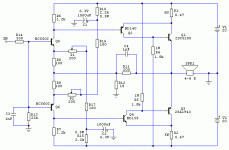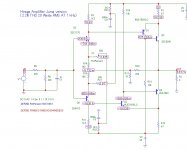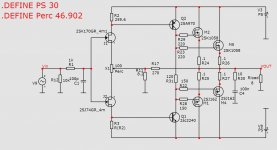Member
Joined 2009
Paid Member
First stage can be left out if we bias the second stage (which now becomes the first stage) through emitters. Something like this:... How do you propose to feed the signal to the second stage without it?
http://www.diyaudio.com/forums/pass-labs/210538-f5-bjt-input.html#post2980905
And if we do it right, Hiraga's design will turn into ALL-BJT-F5...
Hi Hylle,
it will work this way: bootstrap circuits (P1,R17,R15,C2 and P2,R16,R10,C1) polarize the input stage and qonsequently determine the output stage bias and DC offset at the output.
Start adjusting with P1 and P2 at half of their value (which translates into about 1A through Q1,Q2 i.e. 470mV over R1 or R2) and spin both, in small steps, alternatively, until wanted bias and zero DC offset are reached.
Stability should be the same as in the original design and it depends also on BJTs used, so some testing in vivo with different types might be needed. Sufficient heatsinking is a must.
To preserve the original gain of the amp the R12 has to be a bit higher (18 instead of 10R) beacuse it has emitter circuits of Q5,Q6 in parallel.
I calculated the values for +/-20V PSU and if higher or lower voltages are to be used, the value of R10, R15 has to be changed proportionally.
it will work this way: bootstrap circuits (P1,R17,R15,C2 and P2,R16,R10,C1) polarize the input stage and qonsequently determine the output stage bias and DC offset at the output.
Start adjusting with P1 and P2 at half of their value (which translates into about 1A through Q1,Q2 i.e. 470mV over R1 or R2) and spin both, in small steps, alternatively, until wanted bias and zero DC offset are reached.
Stability should be the same as in the original design and it depends also on BJTs used, so some testing in vivo with different types might be needed. Sufficient heatsinking is a must.
To preserve the original gain of the amp the R12 has to be a bit higher (18 instead of 10R) beacuse it has emitter circuits of Q5,Q6 in parallel.
I calculated the values for +/-20V PSU and if higher or lower voltages are to be used, the value of R10, R15 has to be changed proportionally.
Attachments
Last edited:
Thanks Juma, i might play with this circuit when i find some time. one question. is it the only way to use the bootstrap circuit, or is there other ways. Do you like this solution? I am not that happy about the big 1000uf capacitors involved in the circuit, but maybe I dont need to worry about them.
Hi Hylle,
the bootstrap circuit is actually an emulation of constant current source so yes, it can be done in numerous different ways and this one is quite OK.
Yes, the capacitors are evil things - stay away from them at any cost, don't use them at all, not even in the power supply (where they are more involved with signal then here)...
Jokes aside, there are more dangerous beasts to fear than simple caps - all active parts for example, their non-linearity is hard to match.
the bootstrap circuit is actually an emulation of constant current source so yes, it can be done in numerous different ways and this one is quite OK.
Yes, the capacitors are evil things - stay away from them at any cost, don't use them at all, not even in the power supply (where they are more involved with signal then here)...
Jokes aside, there are more dangerous beasts to fear than simple caps - all active parts for example, their non-linearity is hard to match.
BL should be fine. With R31 at 1K there will be 600 mA bias current per MOSFET. I am not sure what the final value was, but even with pretty low bias at 100mA the THD is predominantly second harmonic.Hi Nico,
Thank you for posting the Sigurd's schematic. Can I use BL grade Jfets instead the GR ? How much bias current for this amp?
Kindest regards
Josh
At the time we were playing with Le Monster and he came up with this. I stand corrected and I must take your word for it if it is Zenquito I did not know of its existence. There were a few variations we tried at the time. The idea was to mimic Hiagara's THD distribution with slightly different configurations. I guess that everything exists somewhere in the world, whether it is know or unknown, nothing is ever unique even if you think it is.
Thanks for the web reference anyway seems interesting.
Last edited:
The Hiraga amp has load drive problems because it is a low loop gain, high distortion
kluge with a poor damping factor. In short a massive waste of power, time and money.
It is described as having a "warm" sound which is an obfuscatory term subjectivists use
to describe a sound that is perceptibly distorted.
Want a good amp ? The original Marshall Leach or any Hugh Dean AKSA type for my money any day. The double barreled amp can be tricky to make work reliably.
kluge with a poor damping factor. In short a massive waste of power, time and money.
It is described as having a "warm" sound which is an obfuscatory term subjectivists use
to describe a sound that is perceptibly distorted.
Want a good amp ? The original Marshall Leach or any Hugh Dean AKSA type for my money any day. The double barreled amp can be tricky to make work reliably.
Does it sound good? That's the only question for audio amps. Who cares whether it looks good on the spectrum analyzer.
I am intrigued by the simplicity of the design, there are so many things that you can "improve", but maybe that's not the point. The point is whether it sounds good. This and a CFA are the only the amps I want to build next after I am done with my current one.
Who is to say high damping factor is good? Who say zero distortion is superior? I listened to Krell and Mac, both gone through hoops to lower distortion, they both sounded dead to me.
I am intrigued by the simplicity of the design, there are so many things that you can "improve", but maybe that's not the point. The point is whether it sounds good. This and a CFA are the only the amps I want to build next after I am done with my current one.
Who is to say high damping factor is good? Who say zero distortion is superior? I listened to Krell and Mac, both gone through hoops to lower distortion, they both sounded dead to me.
I agree with you Alan0354, you can not meassure if a circuit makes music sound natural. I have not heard this Hiraga amp myself, but a friend of mine who has a very well regarded amp, he very much prefer this modified hiraga clone amp over his own amp. That made me interrested in this hiraga design. I think it is interesting to investigate a design that takes away the input buffer, because I dont see any use for it.
While some may like the distortion produced by the Hiraga, I am almost certain that your favorite, high quality CD was NOT mastered using one of these power munching monstrosities. Go buy the books by Doug Self and Cordell to learn how accurate low distortion power amplifiers are made. And remember the class D phenomenon is steadily encroaching on the bulky class AB school. Papa Nelson Pass still has a big following, me included. I use one of Hugh Deans amps (Naksa 125), class AB at 120 mA quiescent. Good value, good sound and good service. He DOES answer emails too.
Jcdrisc, by "power munching monstrosities" I take it you mean class A. Please explain why after decades of the conception of the likes of the JLH, Hiraga,Pass, early Krells etc that the DIY community are so fond of them if they are so poor.
Most people on this forum are trying to learn, posts that are so negative are of no benefit to anyone.
We all have our views, each to their own.
Alan
Most people on this forum are trying to learn, posts that are so negative are of no benefit to anyone.
We all have our views, each to their own.
Alan
- Status
- This old topic is closed. If you want to reopen this topic, contact a moderator using the "Report Post" button.
- Home
- Amplifiers
- Solid State
- HIRAGA 'le class a'



